
Quinapril (trade name Accupril) is a drug used to treat hypertension and congestive heart
failure.
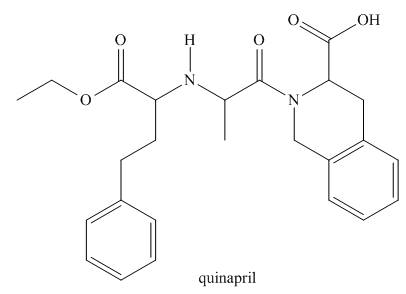
a. Identify the
b. Classify any alcohol, amide or
c. At which sites can quinapril hydrogen bond to water?
d. At which sites can quinapril hydrogen bond to acetone
e. Label the most acidic hydrogen atom.
f. Which site is most basic?
(a)
Interpretation: The functional groups present in the given compound, quinapril are to be identified.
Concept introduction: An atom or a group of atoms that shows characteristic physical and chemical properties are collectively known as functional groups. The functional group is the most reactive part present in the molecule. The main functional groups are
Answer to Problem 3.60P
The functional groups present in the given compound, quinapril are shown below.
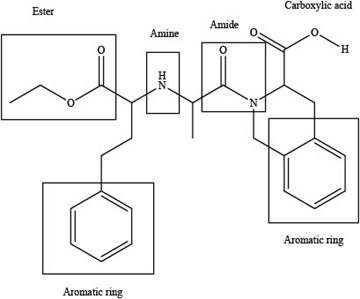
Explanation of Solution
The functional groups present in the given compound, quinapril are shown as,
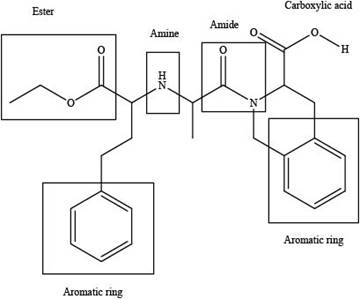
Figure 1
Thus, there are total four functional groups present in quinapril which are ester group, amine group, amide group and carboxylic group as highlighted above. There are two aromatic also present in the given compound, quinapril.
There are total four functional groups present in quinapril which are ester group, amine group, amide group and carboxylic group.
(b)
Interpretation: The alcohol, amine or amide groups present in the given compound, quinapril are to be classified as
Concept introduction: The amine, amide or alcoholic groups are identified as primary
Answer to Problem 3.60P
The classification of alcohol, amine or amide groups present in the given compound, quinapril as
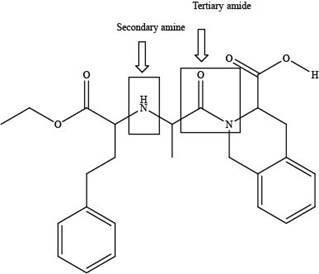
Explanation of Solution
The classification alcohol, amine or amide groups present in the given compound, quinapril are shown as,
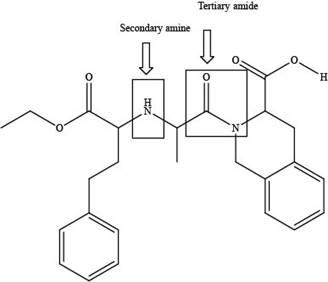
Figure 2
The given compound consists of one tertiary amide and one secondary amine as shown above.
The classification of alcohol, amine or amide groups present in the given compound, quinapril as
(c)
Interpretation: The site at which quinapril forms hydrogen bond with water is to be predicted.
Concept introduction: The bonding that takes place between hydrogen atom and hetero atoms like oxygen, nitrogen and fluorine is known as hydrogen bonding. In case of water, hydrogen atom makes bond with each other. Hydrogen bonding is the strongest bonding among the intermolecular forces and covalent bonding.
Answer to Problem 3.60P
The site at which quinapril forms hydrogen bond with water is shown below.
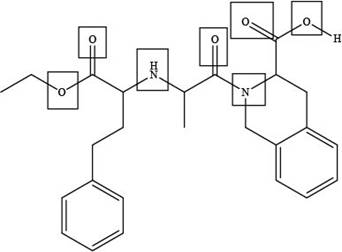
Explanation of Solution
The site at which quinapril forms hydrogen bond with water is shown as,

Figure 3
In the given compound, the sites where the electronegative atoms like, oxygen and nitrogen are present, there only hydrogen bond forms with water as highlighted above.
The site at which quinapril forms hydrogen bond with water is shown in Figure 3.
(d)
Interpretation: The site at which quinapril forms hydrogen bond with acetone is to be predicted.
Concept introduction: The bonding that takes place between hydrogen atom and hetero atoms like oxygen, nitrogen and fluorine is known as hydrogen bonding. In case of acetone, hydrogen atom makes bond with that electronegative atom which is attached to hydrogen atom only. Hydrogen bonding is the strongest bonding among the intermolecular forces and covalent bonding.
Answer to Problem 3.60P
The site at which quinapril forms hydrogen bond with acetone is shown below.
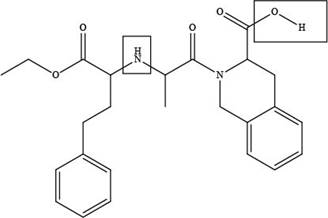
Explanation of Solution
The site at which quinapril forms hydrogen bond with acetone is shown as,

Figure 4
In the given compound, the sites where the electronegative atoms like, oxygen and nitrogen attached to other hydrogen atom are present, there only hydrogen bond forms with acetone as highlighted above.
The site at which quinapril forms hydrogen bond with acetone is shown in Figure 4.
(e)
Interpretation: The most acidic hydrogen present in the given compound, quinapril is to be labeled.
Concept introduction: The most acidic hydrogen
Answer to Problem 3.60P
The labeling of the most acidic hydrogen present in the given compound, quinapril is shown below.
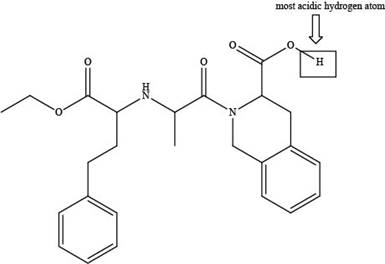
Explanation of Solution
The labeling of the most acidic hydrogen present in the given compound, quinapril is shown as,

Figure 5
The electronegativity increases while moving left to right in the period. Thus, oxygen is more electronegative than nitrogen atom as it is located at the extreme right position. According to the structure of quinapril, hydrogen atom that is bonded with oxygen atom is the most acidic one because oxygen is more electronegative than nitrogen atom. The higher electronegativity corresponds to the greater acidic character of hydrogen atom attached to the electronegative atom.
The labeling of the most acidic hydrogen present in the given compound, quinapril is shown in Figure 5.
(f)
Interpretation: The most basic site in the compound quinapril is to be labeled.
Concept introduction: According to Bronsted-Lowry theory, the species that easily tends to accept the proton is known as base and the species that easily donate the proton is known as acid. The high delocalization of electron pair corresponds to the high basic character of the atom.
Answer to Problem 3.60P
The labeling of the most basic site in the compound quinapril is shown below.
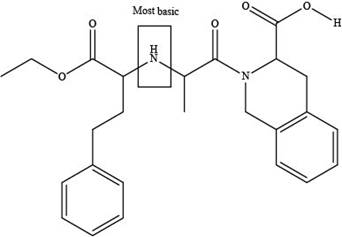
Explanation of Solution
The labeling of the most basic site in the compound quinapril is shown as,
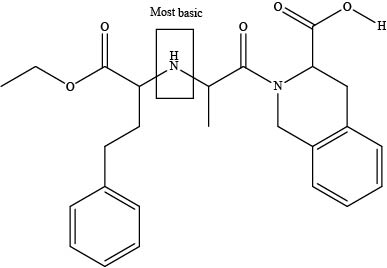
Figure 6
According to the structure of quinapril, the site at which amide group is present is the most basic site because in amides, the pair of electrons over nitrogen atom gets highly delocalized. Hence, the most basic site is present at tertiary amide.
The labeling of the most basic site in the compound quinapril is shown in Figure 6.
Want to see more full solutions like this?
Chapter 3 Solutions
ORGANIC CHEMISTRY
- € + Suppose the molecule in the drawing area below were reacted with H₂ over a platinum catalyst. Edit the molecule to show what would happen to it. That is, turn it into the product of the reaction. Also, write the name of the product molecule under the drawing area. Name: ☐ H C=0 X H- OH HO- H HO- -H CH₂OH ×arrow_forwardDraw the Haworth projection of the disaccharide made by joining D-glucose and D-mannose with a ẞ(1-4) glycosidic bond. If the disaccharide has more than one anomer, you can draw any of them. Click and drag to start drawing a structure. Xarrow_forwardEpoxides can be opened in aqueous acid or aqueous base to produce diols (molecules with two OH groups). In this question, you'll explore the mechanism of epoxide opening in aqueous acid. 2nd attempt Be sure to show all four bonds at stereocenters using hash and wedge lines. 0 0 Draw curved arrows to show how the epoxide reacts with hydronium ion. 100 +1: 1st attempt Feedback Be sure to show all four bonds at stereocenters using hash and wedge lines. See Periodic Table See Hint H A 5 F F Hr See Periodic Table See Hintarrow_forward
- 03 Question (1 point) For the reaction below, draw both of the major organic products. Be sure to consider stereochemistry. > 1. CH₂CH₂MgBr 2. H₂O 3rd attempt Draw all four bonds at chiral centers. Draw all stereoisomers formed. Draw the structures here. e 130 AN H See Periodic Table See Hint P C Brarrow_forwardYou may wish to address the following issues in your response if they are pertinent to the reaction(s) you propose to employ:1) Chemoselectivity (why this functional group and not another?) 2) Regioselectivity (why here and not there?) 3) Stereoselectivity (why this stereoisomer?) 4) Changes in oxidation state. Please make it in detail and draw it out too in what step what happens. Thank you for helping me!arrow_forward1) Chemoselectivity (why this functional group and not another?) 2) Regioselectivity (why here and not there?) 3) Stereoselectivity (why this stereoisomer?) 4) Changes in oxidation state. Everything in detail and draw out and write it.arrow_forward
- Calculating the pH at equivalence of a titration 3/5 Izabella A chemist titrates 120.0 mL of a 0.7191M dimethylamine ((CH3)2NH) solution with 0.5501 M HBr solution at 25 °C. Calculate the pH at equivalence. The pk of dimethylamine is 3.27. Round your answer to 2 decimal places. Note for advanced students: you may assume the total volume of the solution equals the initial volume plus the volume of HBr solution added. pH = ☐ ✓ 18 Ar Boarrow_forwardAlcohols can be synthesized using an acid-catalyzed hydration of an alkene. An alkene is combined with aqueous acid (e.. sulfuric acid in water). The reaction mechanism typically involves a carbocation intermediate. > 3rd attempt 3343 10 8 Draw arrows to show the reaction between the alkene and hydronium ion. that 2nd attempt Feedback 1st attempt تعمال Ju See Periodic Table See Hint F D Ju See Periodic Table See Hintarrow_forwardDraw the simplified curved arrow mechanism for the reaction of acetone and CHgLi to give the major product. 4th attempt Π Draw the simplified curved arrow mechanism T 3rd attempt Feedback Ju See Periodic Table See Hint H -H H -I H F See Periodic Table See Hintarrow_forward
- Select the correct reagent to accomplish the first step of this reaction. Then draw a mechanism on the Grignard reagent using curved arrow notation to show how it is converted to the final product. 4th attempt Part 1 (0.5 point) Select the correct reagent to accomplish the first step of this reaction. Choose one: OA Mg in ethanol (EtOH) OB. 2 Li in THF O C. Li in THF D. Mg in THF O E Mg in H2O Part 2 (0.5 point) Br Part 1 Bri Mg CH B CH, 1 Draw intermediate here, but no arrows. © TE See Periodic Table See Hint See Hint ין Harrow_forwardSelect the product for the following reaction. HO HO PCC OH ○ OH O HO ○ HO HO HOarrow_forward5:45 Х Select the final product for the following reaction sequence. O O 1. Mg. ether 2.D.Oarrow_forward
- Chemistry: Matter and ChangeChemistryISBN:9780078746376Author:Dinah Zike, Laurel Dingrando, Nicholas Hainen, Cheryl WistromPublisher:Glencoe/McGraw-Hill School Pub Co
 Chemistry for Today: General, Organic, and Bioche...ChemistryISBN:9781305960060Author:Spencer L. Seager, Michael R. Slabaugh, Maren S. HansenPublisher:Cengage Learning
Chemistry for Today: General, Organic, and Bioche...ChemistryISBN:9781305960060Author:Spencer L. Seager, Michael R. Slabaugh, Maren S. HansenPublisher:Cengage Learning

